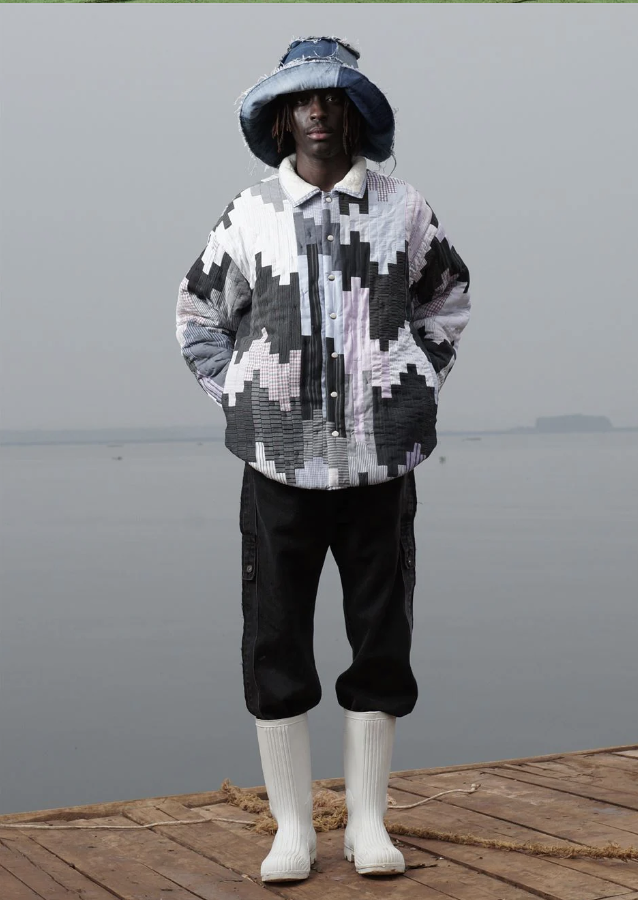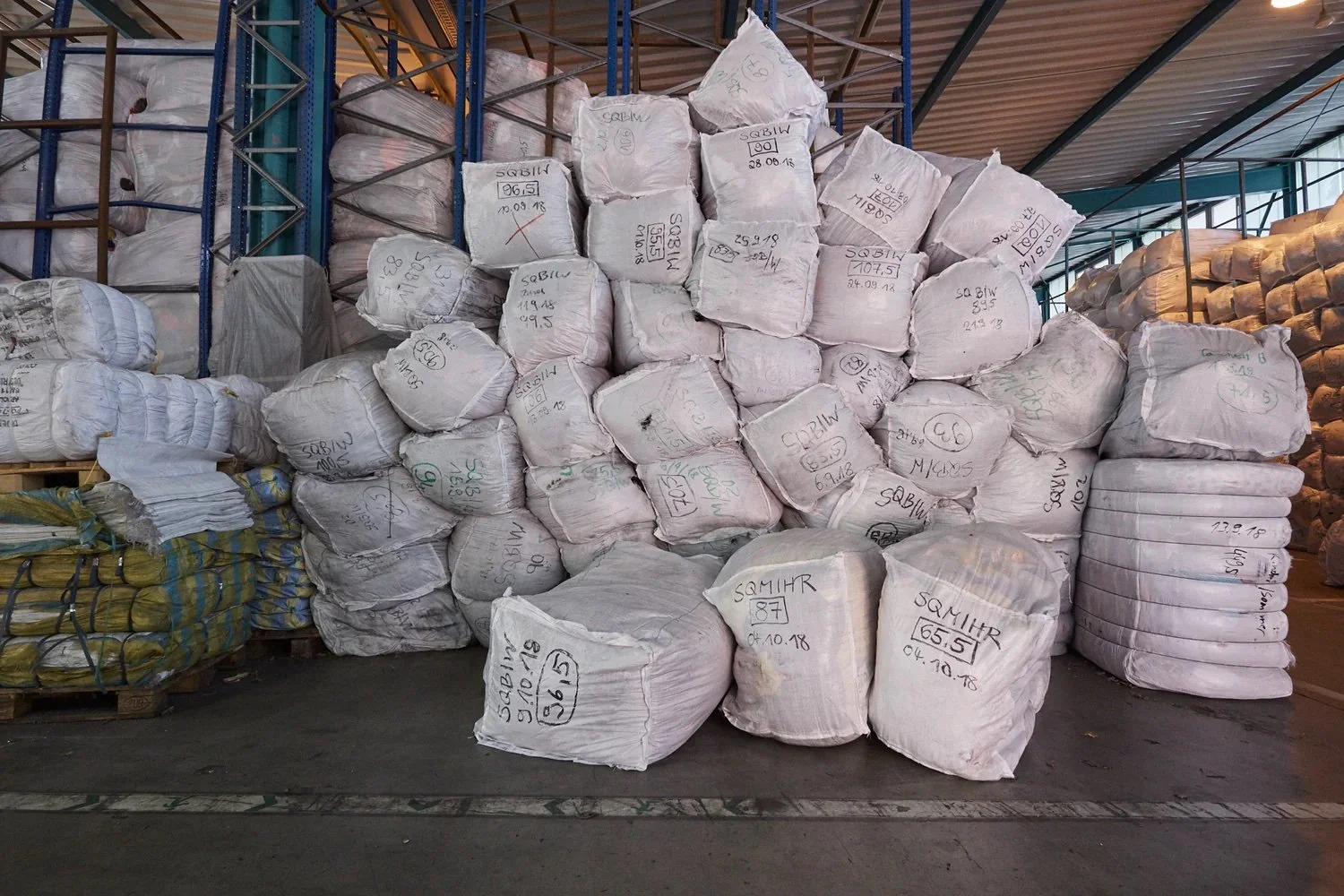Bobby Kolade is the designer behind Ugandan fashion label Buzigahill - which puts the politics of upcycling and waste colonialism at its core with the brilliant, provocative concept: Return to Sender.
Buzigahill's collections are made from items of secondhand clothing donated in the global north, and increasingly being dumped on the global south in unsustainable numbers. Why “return to sender”? Because much of Buzigahill’s clientele is in Europe and North America.
Much like Kantamanto in Accra, Ghana; Owino Market in Kampala receives huge numbers of bales of second-hand clothing from countries in Europe, from the US and Canada every week. As a result, second-hand accounts for 80 % of all domestic clothing sales in Uganda.
But how much is too much? Who is monitoring for quality and consistency? Are we right to keep thinking about "donations" in the context of this undeniably big business? As Bobby says, it's not charity - it's a trade, and too often an unequal one.
So surely it's good, right, when a receiving country finally says: "No more! We don't want your cast-offs." Or is it? As usual, there’s no simple answer.
This enthralling conversation was recorded before Uganda’s government announced a ban on second-hand clothing towards the end of last year. A situation that continues to evolve.
NOTES
First, let’s get the LUXURY FASHION HISTORY REFS out of the way… French-Belgian designer NICHOLAS GHESQUIERE helmed BALENCIAGA from 1997 - 2012. This 2013 article by PIERRE-ALEXANDRE DE LOOZ for 032C mag is the best reader we’ve found on Ghesquière’s work at the house - highly recommended.
In 2013, Ghesquière moved to Louis Vuitton, where he’s been women's creative director ever since. These days you may know MARGIELA for the excesses of Galliano, but the OG (house founder, Martin Margiela, who started his label in 1989 after working for Gaultier) was actually an early upcycler.
Margiela Porcelain waistcoat, 1989-1990
UGANDA is an East African Nation, bordering Kenya, South Sudan, Rwanda, DRC, and Tanzania. KAMPALA is the capital and largest city, with a population of around 1.7 million. It’s in the hills south of Lake Victoria, with a beautiful climate. The country is a biodiversity hotspot - with 10 national parks, it’s home to a huge diversity of species, including protected Mountain Gorillas.
CHILE & THE CLOTHES PILE SO BIG YOU CAN SEE IT FROM SPACE, until you can’t.
LISTEN to the podcast Bobby co-hosts with filmmaker Nikissi Serumaga, VINTAGE OR VIOLENCE on Spotify.
Find Ep 150 with Liz Ricketts here.
Beyond RETURN TO SENDER, BUZIGAHILL collaborates with visual artists, fashion designers, second-hand market vendors and artisanal workshops in Uganda to add value to local supply chains and develop strong creative industries.” Discover here.
They say: “BUZIGAHILL is named after a neighbourhood in Kampala in which Bobby Kolade and a group of friends from the visual arts, music and film scene lived during the inception stage. It is a special part of the city, with lake views, mature vegetation and architectural memories of a bygone era.”
Want more? Read this excellent interview with Bobby from ATMOS magazine.
Image via https://buzigahill.com/pages/about
HISTORY
The city today known as Kampala “was founded in the 19th Century, when the king of Buganda had his seat in the hills. When the British arrived here at the end of the century, they named this place as the ‘Hill of the Impala’ because it was frequented by large numbers of Impalas (which belong to the antelope family)...
In 1890, Frederick Lugard constructed a fort for the British East Africa Company here. Kampala grew up around that fort. In 1962, Kampala replaced Entebbe as the national capital. Much of the city was destroyed after the 1979 overthrow of Idi Amin’s dictatorship and the subsequent civil war. The city grew as the capital of Buganda, from which several buildings survive, including the Kasubi Tombs (built in 1881), the Buganda Parliament, the Buganda Court of Justice and the Naggalabi Buddo Coronation Site. Severely damaged in the Ugandan-Tanzanian War, the city has since been rebuilt. Manufactures include furniture and machine parts. Agricultural exports include coffee, cotton, tea, and sugar.” Via Visit Kampala.
BUZIGA is Kampala's second-highest hill, at 4,322 feet above sea level.
UGANDA was a British colony from 1894 to 1962.
Military dictator General IDI AMIN ruled Uganda from 1971 to 1979. He carried out mass killings within the country to maintain his rule. An estimated 80,000–500,000 Ugandans died during his regime. He also expelled the Indian minority (who, in a similar way to that detailed in Episode 202 about Fiji, had been brought in by the British as indentured labourers). As Bobby mentions, Ugandans of Indian descent played a significant factory owners and key players in the UGANDAN COTTON INDUSTRY.
COTTON The country was once one of the biggest producers in Sub-Saharan Africa. Cotton was introduced as a cash crop by the colonialists in 1903. According to Nitin Arora, a cotton professional from Fine Spinners Uganda: “It served the dual purposed of providing raw material for the industries in the West as well as introducing cash economy in Uganda. During this period cotton production received a boost because of the introduction of a poll tax by the colonial government, which was to be paid with cotton.”
Today it’s still a rain-fed crop with low pesticide use (and organic cotton, which commands a higher price, was introduced in the 1990s. Many small holders still produce cotton in rotation with other crops, however, the industry is in decline. “Ginneries are required to sell 20% of all their seed to CDO for replanting, and the rest, totalling about 32,000 tons, is sold to oil mills for crushing. Ugandan cotton is reputed to be very contaminated and quality control at the primary level has broken down. Ginning overcapacity has led to a scramble for cotton and a large number of buyers purchase seed cotton regardless of quality, forcing others to do the same. Research shows that less than 20% of the potential is exploited. This is due to the low level of industrialisation and weak intra-industry linkages both in Uganda and the region.” Read the rest here.
The African Growth and Opportunity Act (AGOAA) is “the African Growth and Opportunity Act is “has been at the core of U.S. economic policy and commercial engagement with Africa. AGOA provides eligible sub-Saharan African countries with duty-free access to the U.S. market for over 1,800 products, in addition to the more than 5,000 products that are eligible for duty-free access under the Generalized System of Preferences program.” Via Office of the United States Trade Representative. More here.
In August 2023, Uganda's president announced a surprise national ban on second hand clothing imports. This just so happened to coincide with some major Chinese investment in a textile factory complex outside of the capital.
Now this certainly was not without precedent - you may remember when the East Africa community (EAC bloc nations tried this in 2019 - there was massive pushback from the US, who threatened these countries - Uganda Kenya, Uganda, Tanzania, Rwanda and Burundi, with expulsion from AGOAA. They all caved in except Rwanda.
More here.
Fast fwd, and here's Uganda, with it back on the table. At first, I wondered if Bobby might be cheering about this, his own label's jeopardised feedstocks not withstanding. But it's more complicated than that.
Says Bobby: "According to the Uganda Dealers in Used Clothing and Shoes Association, there are more than 4 million Ugandans directly and indirectly active in the used-clothing and textiles supply chain. Orders for secondhand clothes from suppliers in China, the US, Canada, the UK, Turkey, Australia and the UAE had already been placed before the end-of-year holiday season. Under the proposed ruling, would the containers en route to Uganda be sent back? Will the 50,000 vendors at Owino Market be compensated, or sent home? What happens to all the small businesses upcycling secondhand clothes?"
Clare mentions interviewing Kampala-based model agent JORAM MUJIRA-JOB. Listen to him on the Ethical Fashion Podcast here.
THANK YOU FOR LISTENING. Please do get in touch if you like the show, and help us continue to make it by growing our audience. Sharing it on social media, or just with your friends, rating, reviewing or simply recommending it, makes a huge difference.
Find Clare on Instagram @mrspress (& rarely these days, but anyway, X @mrspress).











